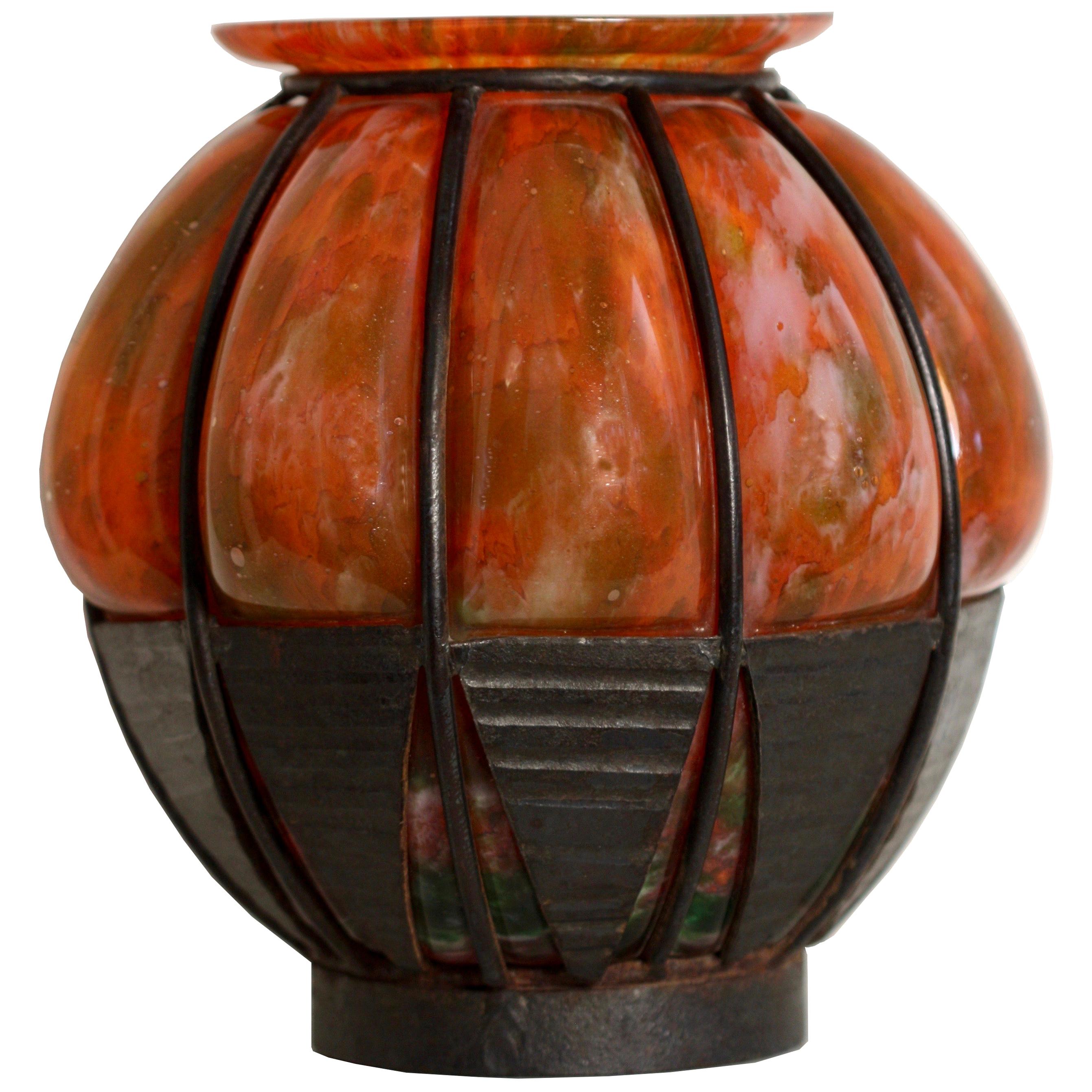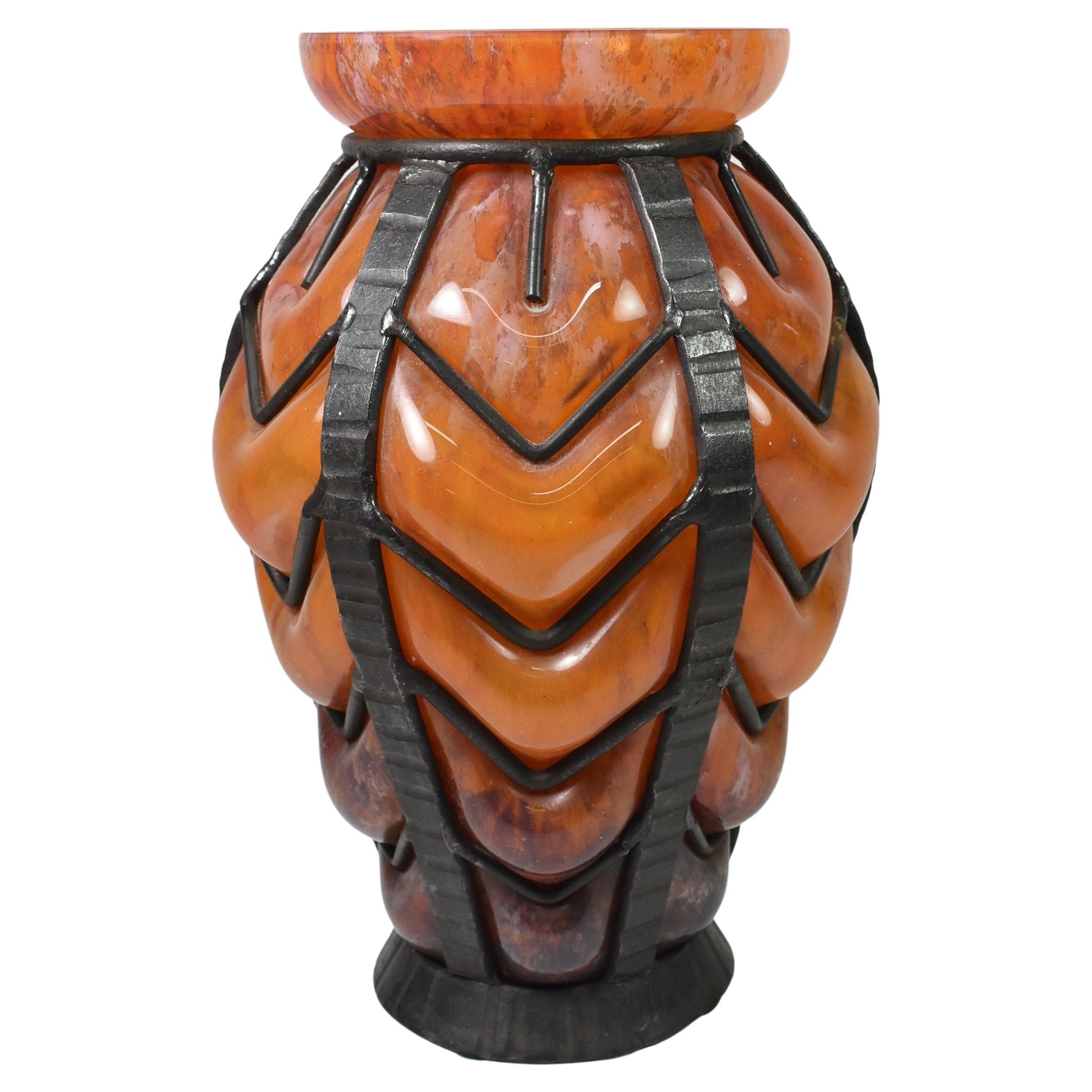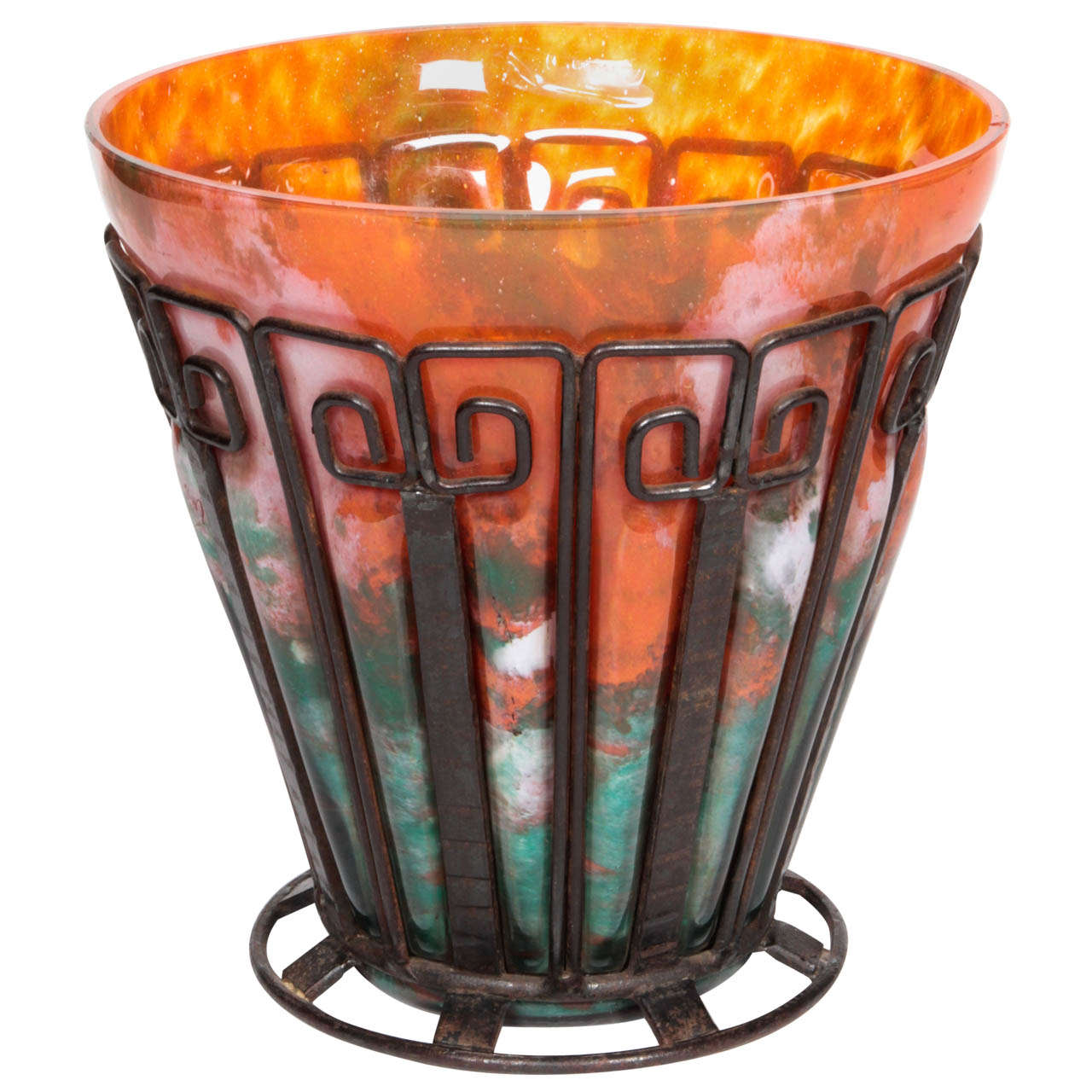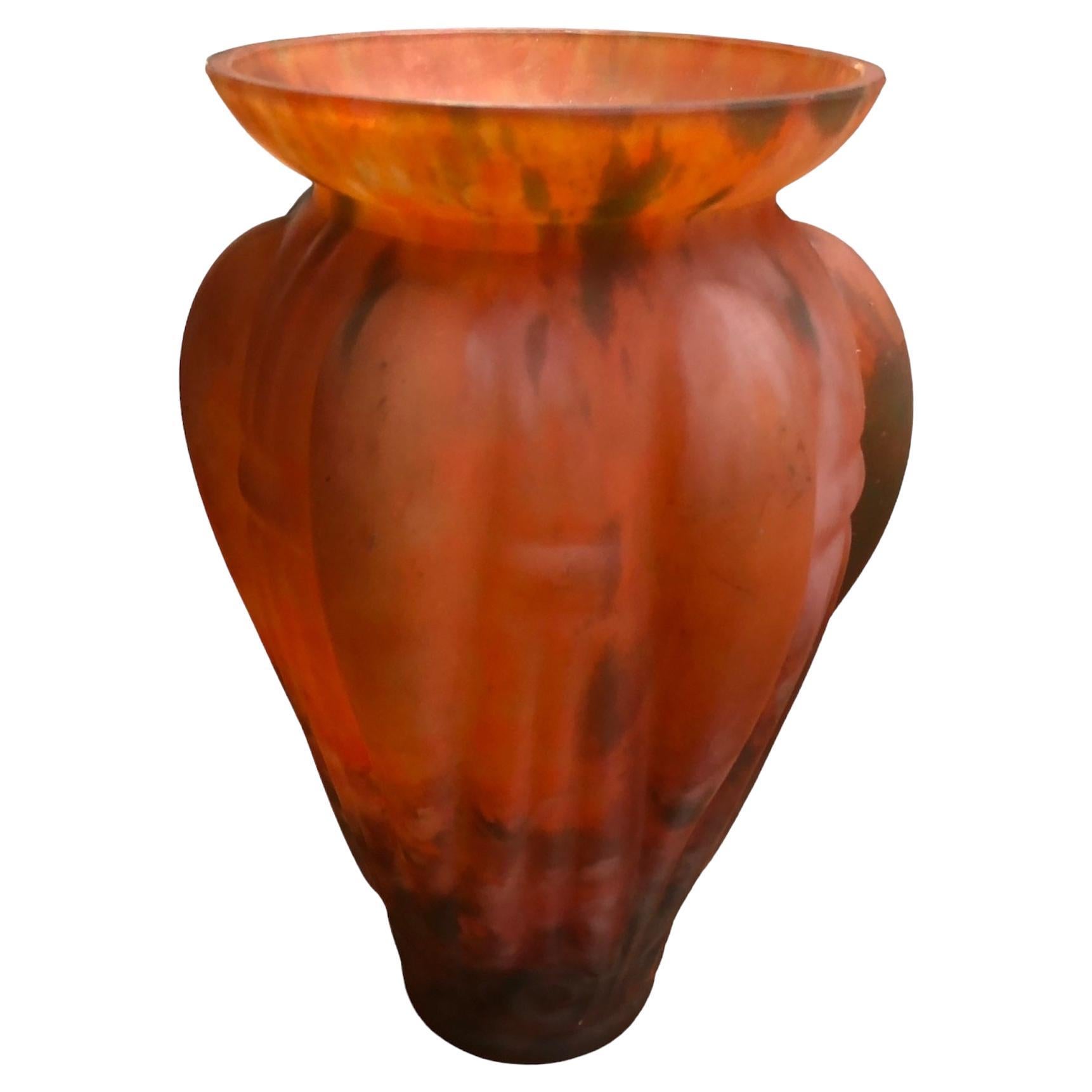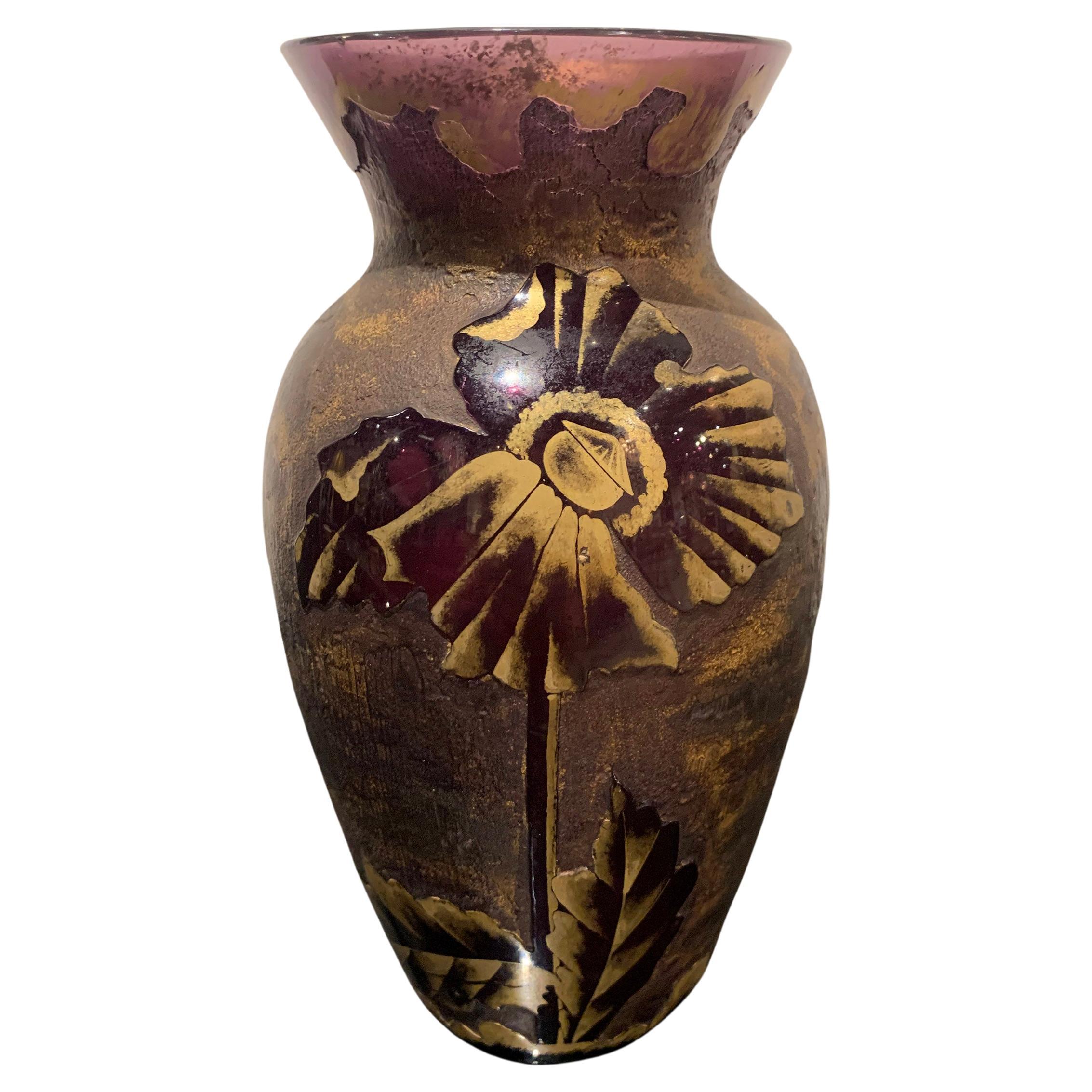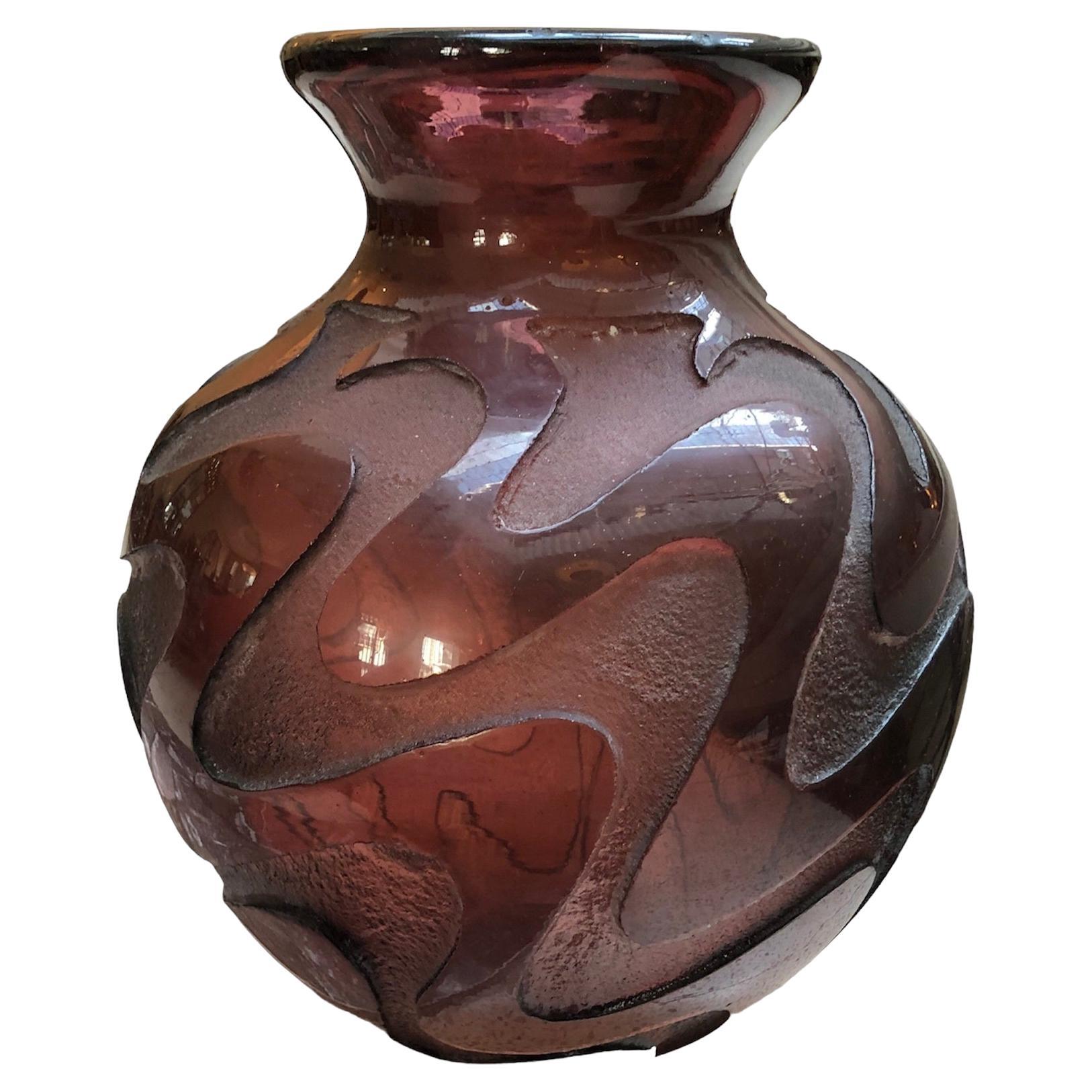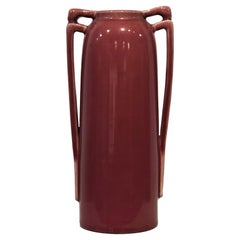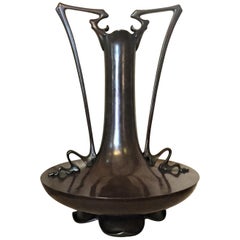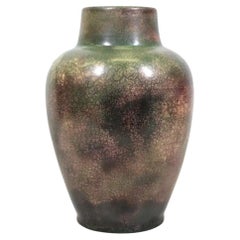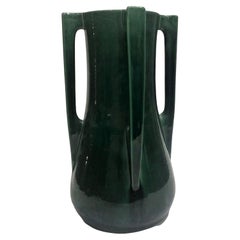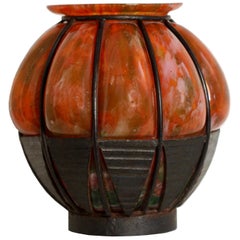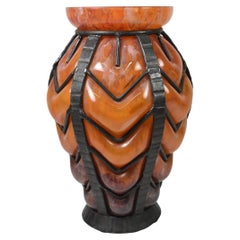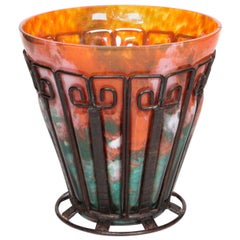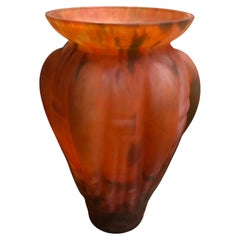Items Similar to French Art Deco Art Glass and Wrought Iron Flower Vase, circa 1920s
Want more images or videos?
Request additional images or videos from the seller
1 of 9
French Art Deco Art Glass and Wrought Iron Flower Vase, circa 1920s
$3,800
£2,884.90
€3,299.70
CA$5,309.15
A$5,904.93
CHF 3,083.37
MX$71,856.78
NOK 39,379.38
SEK 36,930.92
DKK 24,626.96
Shipping
Retrieving quote...The 1stDibs Promise:
Authenticity Guarantee,
Money-Back Guarantee,
24-Hour Cancellation
About the Item
Although unsigned, this Art Deco masterpiece in red and white art glass and wrought iron most probably by Charles Schneider.
Charles and Ernest Schneider were a generation younger than Emile Galle and the Daum brothers, whose glassworks were in the same area of France. The Schneider brothers worked for Daum from the early 1900s, Ernest as a salesman/commercial manager, and Charles as a freelance designer.
The brothers left Daum circa 1912, and recommissioned an old glassworks under the name Schneider Freres et Wolff (Schneider Brothers and Wolff), a few miles north of Paris in 1913. Henri Wolff was an architect friend of Charles Schneider.
Initially they made high quality cameo vases and lamps, but the war in Europe (1914-1918) led Charles and Ernest and most of their skilled glassworkers away to fight in the war. They returned and re-opened their glassworks in 1917 to make glassware needed for hospitals, and after the war they sold shares in the company to finance getting back into the art glass market. At that time the company was called the Societe Anonyme des Verreries Schneider.
Charles Schneider was a brilliant and versatile designer, and the company produced a wide range of superb designs of vases, ewers, bowls, and lamps. They were very successful in marketing their glass to major high prestige retail stores both in Paris and overseas. They bought back their shares and re-named the company Verrerie Schneider.
- Attributed to:Charles Schneider (Maker)
- Dimensions:Height: 11.75 in (29.85 cm)Diameter: 13.38 in (33.99 cm)
- Style:Art Deco (Of the Period)
- Materials and Techniques:
- Place of Origin:
- Period:
- Date of Manufacture:circa 1920s
- Condition:Wear consistent with age and use. We make our best effort to provide a fair and descriptive condition report. Send message to this seller to request more details or discuss price.
- Seller Location:New York, NY
- Reference Number:1stDibs: LU2819320560132
About the Seller
5.0
Vetted Professional Seller
Every seller passes strict standards for authenticity and reliability
Established in 1993
1stDibs seller since 2017
83 sales on 1stDibs
Typical response time: 7 hours
- ShippingRetrieving quote...Shipping from: New York, NY
- Return Policy
Authenticity Guarantee
In the unlikely event there’s an issue with an item’s authenticity, contact us within 1 year for a full refund. DetailsMoney-Back Guarantee
If your item is not as described, is damaged in transit, or does not arrive, contact us within 7 days for a full refund. Details24-Hour Cancellation
You have a 24-hour grace period in which to reconsider your purchase, with no questions asked.Vetted Professional Sellers
Our world-class sellers must adhere to strict standards for service and quality, maintaining the integrity of our listings.Price-Match Guarantee
If you find that a seller listed the same item for a lower price elsewhere, we’ll match it.Trusted Global Delivery
Our best-in-class carrier network provides specialized shipping options worldwide, including custom delivery.More From This Seller
View AllJapanese Art Nouveau Awaji Ware Art Studio Pottery Flower Vase, ca. 1900s
Located in New York, NY
Japanese Art Nouveau
Flower Vase
Awaji Ware Art Studio Pottery
ca. 1900s
ABOUT AWAJI WARE ART STUDIO POTTERY
Awaji pottery was made on the Japanese island of the same name between...
Category
Antique Early 1900s Japanese Art Nouveau Vases
Materials
Pottery
Japanese Art Nouveau Meiji Period Patinated Bronze Vase, circa 1900
Located in New York, NY
Although unmarked, this rare and important, grand but at the same exquisite patinated bronze vase has just a very few little details, defying the shape of the handles, as well as the...
Category
Antique Early 1900s Japanese Art Nouveau Vases
Materials
Bronze
Arts & Crafts Chinese-Form Ceramic Vase, ca. 1900
By Roseville Pottery
Located in New York, NY
American Arts & Crafts
Chinese-Form Pauleo Pattern Glazed Ceramic Vase
In Manner of Roseville for Tiffany
Circa 1900
DIMENSIONS
Height: 15.75 inches (40.01 cm)
Diameter: 10.5 inch...
Category
Antique Early 1900s American Art Nouveau Vases
Materials
Ceramic
Japanese Art Nouveau, Awaji Ware Art Studio Pottery Flower Vase, Ca. 1900
By Awaji Pottery
Located in New York, NY
DIMENSIONS:
Height: 12.5 inches
Width: 6.75 inches
Depth: 6.75 inches
ABOUT AWAJI POTTERY
Awaji pottery was made on the Japanese island of the same name between 1830 and 19...
Category
Antique Early 1900s Japanese Art Nouveau Vases
Materials
Ceramic
Alfonso Canciani, Viennese Secession Orientalist Bronze Vase, c. 1910
By Alfonso Canciani
Located in New York, NY
Alfonso Canciani (Italian-Austrian, 1863-1955) was a famous Italian-Austrian sculptor of the period of accession to the Viennese Secession. Son of a stonemason, after a realist period he managed to establish himself as a leading sculptor of the Viennese Secession. In fact, he worked in Vienna, where he had enrolled in 1886 at the Academy of Fine Arts, then at the Higher School of Sculpture and finally at the Special School, where he obtained the Rome prize for the sketch for Dante's Monument.
He developed a notable business obtaining important prizes and numerous commissions. First among the sculptors of the Viennese capital, he was invited to join the Association of the Viennese Secession, of which Klimt was magna pars, after the exhibition of Dante's group in 1900 at the Secession exhibition, and obtained the most important Austrian artistic prize, the Kunstlerlpreis.
This same work, presented in 1910 in Berlin, at the Great Art Exhibition, also received an important recognition here. He obtained the Rome prize in 1896, exhibited successfully in Munich and in 1899 at the III International Art Exhibition in Venice.
In that period he made some statues of saints for the cathedral of Santo Stefano in Vienna, the monument to Wagner, the bust of Nietzsche for the University, the scepter and the gold chain of the University Rector, figures of Italian poets ( Petrarch, Boccaccio, Tasso, Ariosto).
He submitted a sketch for the official monument to Empress Elizabeth, which was then built in Austrisn Gföhl and Pula. At the time of his accession to the Secession, he dedicated himself to decorating the facade of the Artaria house in Vienna in collaboration with the architect Max Fabiani.
He later abandoned the symbolist decorativism of the Jugendstil for a more concentrated and vigorous style, approaching the Belgian sculptor Constantin Meunier for the theme of work, and preferring to exhibit at the Künstlerhaus.
In Vienna, he was generous with advice and help with the Italians and in particular with his fellow citizens (such as the Brazzanese Luigi Visintin, then a university student).
After the First World War, he returned to Italy and lived in Friuli, penalized by the fact that the Habsburg Empire had by now disappeared. Instead of large-scale public monuments, he then devoted himself to engraving medals (e.g. for Benedict XV and for the Italian mission in Vienna in 1919) and to designing funeral monuments (examples in Mali Lošinj and Trieste) and portrait busts (of Generals Carlo Caneva and Antonio Baldissera in Udine, sculptures of the War Memorial of Corno di Rosazzo). After all, he had already executed the Bab grave monument in the Döblinger cemetery in Vienna in 1909.
He taught in Trieste from 1920 until 1935, at the local school of industrial art, where he had Marcello Mascherini...
Category
Vintage 1910s Austrian Jugendstil Vases
Materials
Bronze
Paul Dachsel for Turn Teplitz, Austrian Jugenstil Ceramic ‘Fern’ Vase, ca. 1900
By Paul Dachsel
Located in New York, NY
DETAILS:
Fully marked on bottom.
DIMENSIONS:
height: 6.75 inches, width: 4.5 inches, depth: 4.5 inches
ABOUT THE ARTIST
Paul Dachsel (Czech, born circa 1880) was the son-in-law of Alfred...
Category
Antique Early 1900s Austrian Art Nouveau Vases
Materials
Ceramic
You May Also Like
Fine Art Deco Schneider Glass and Wrought Iron Vase by Charles Schneider
By Charles Schneider
Located in West Palm Beach, FL
Charles Schneider (1881-1953)
A fine Art Deco Schneider Glass and wrought iron vase,
circa 1920
orange glass with white and pink powders, in a patinated wrought iron case
engr...
Category
Vintage 1920s Vases
Materials
Glass
Nancy Daum and Majorelle Art Deco Blow Out Vase with Steel Frame
By Louis Majorelle, Daum
Located in Toledo, OH
A Nancy Daum and Louis Majorelle Art Deco French art glass vase. This stunning vase features a blown glass vase in variegated shades of orange, with...
Category
20th Century French Art Deco Vases
Materials
Glass
French Art Deco Hand-Hammered Iron and Glass Vase Signed Lorrain
By Lorrain
Located in New York City, NY
A fine Lorrain Nancy / School of Nancy original, hand-hammered wrought iron framed Art Deco glass vase with handblown mottled glass inset in
colorful shades of orange, blue / green ...
Category
20th Century French Art Deco Vases
Materials
Art Glass
Vase Lorrain, Made in France, 1926
Located in Ciudad Autónoma Buenos Aires, C
Lorraine glass
La Verrerie d'Art Lorrain was a Daum brand created by Paul Daum and Pierre D'Avesn at the Belle Etoile glassworks located in Croismare.
Verreries de Belle Etoile, DAUM...
Category
Vintage 1920s French Art Deco Glass
Materials
Glass
French Art Deco Acid Etched Glass Vase, Attributed to Daum
Located in Lyndhurst, NJ
An unusual Art Deco lavender glass vase probably by Daum Nancy, roughened acid etched surface with gilt overlay.
Category
Vintage 1930s French Art Deco Vases
Materials
Art Glass
Vase Sign: Degué, Made in France, 1926, Art Deco
By Degué
Located in Ciudad Autónoma Buenos Aires, C
Degue : David Guéron design Edouard Cazaux
David Gueron, Turkish and a former fighter of the French Foreign Legion, was the founder of the "Cristalleries De Compiegne". This glasswo...
Category
Vintage 1920s French Art Deco Glass
Materials
Glass
More Ways To Browse
Paris Flower Market
1920s Art Deco Vases
Art Deco Flower Vase
1920 Flower Vase
French Art Glass Flower Vase
Cameo Vase
1920s Wrought Iron
Galle Vase Art Deco
Antique Old Paris Vases
Art Deco Glassware
Flowers In Wrought Iron
Art Deco Daum Vase
Brown 1920s Vases Glass
Art Deco Glass Vase Red
Cameo 1920s
White Vase 1900s
Cameo Lamp
Antique Glass Bowls And Vases
